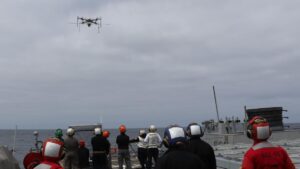The Navy and Marine Corps Small Tactical UAS program office (PMA-263) held a sea-based Unmanned Aircraft Systems (UAS) wide-area mission demonstration in July to assess potential capabilities to aid the future fleet.
The event was organized by PMA-263, Naval Air Warfare Center Aircraft Division (NAWCAD) AIRWorks, and Navy Warfare Development Command (NWDC). It lasted July 11-15 aboard the USS Paul Hamilton
(DDG-60) guided-missile destroyer in San Diego.

The event allowed Insitu Inc. and L3Harris Technologies [LHX] to exhibit multiple technologies designed to operate as a portable system in “challenging conditions while providing the same wide-area coverage as a shore-based system,” the service said in a statement.
The systems demonstrated this wide-area surveillance capability across several mission sets. The Navy said the government will now review data gathered during the demonstration to further evaluate each system’s performance.
Previously, the first steps involved PMA-263 and AIRWorks working with Innovation and Modernization Patuxent River (IMPAX), NAWCAD’s partner for experimentation, technology demonstrations, and prototyping and NWCD’s fleet experimentation team to identify UASs capable of performing wide-area missions from a surface vessel.
The team specifically sought UAS candidates capable of operating at long ranges for extended periods while also relaying accurate and relevant information back to the ship.
They downselected to these two vendors to participate in the demonstration based on their ability to “provide a system able to operate without additional support systems, deploy without dedicated launch or recovery equipment, and have maximum portability, self-sufficiency, and modularity across UAS hardware and payloads,” the Navy said.
“This event was a great opportunity to evaluate unmanned capability in a relevant environment, learn how it can support and enhance operations, and get direct feedback from the fleet. A lot of work was done in a short time across the enterprise to make this happen,” Col. Victor Argobright, PMA-263 program manager, said.
Argobright said both Insitu and L3Harris “stepped up to the challenge,” while the crew of DDG-60 provided good feedback and support.
“It’s teamwork like this that’s needed to get capability in the hand of sailors as quickly as possible. We will be leveraging this effort and working with Navy leadership on the next steps to make this happen,” he continued.
The service said this demonstration is part of a merit-based selection process that may lead to Insitu or L3Harris being awarded an Other Transaction Authority (OTA) prototype project later this year. The Navy did not disclose the value of the contract.
The Defense Department generally uses OTAs for prototype, research and production projects.